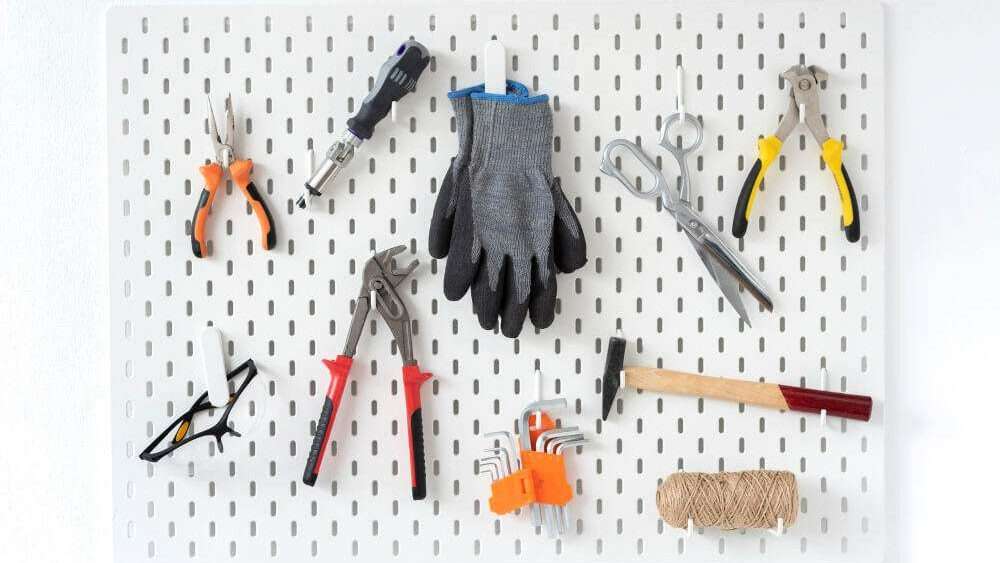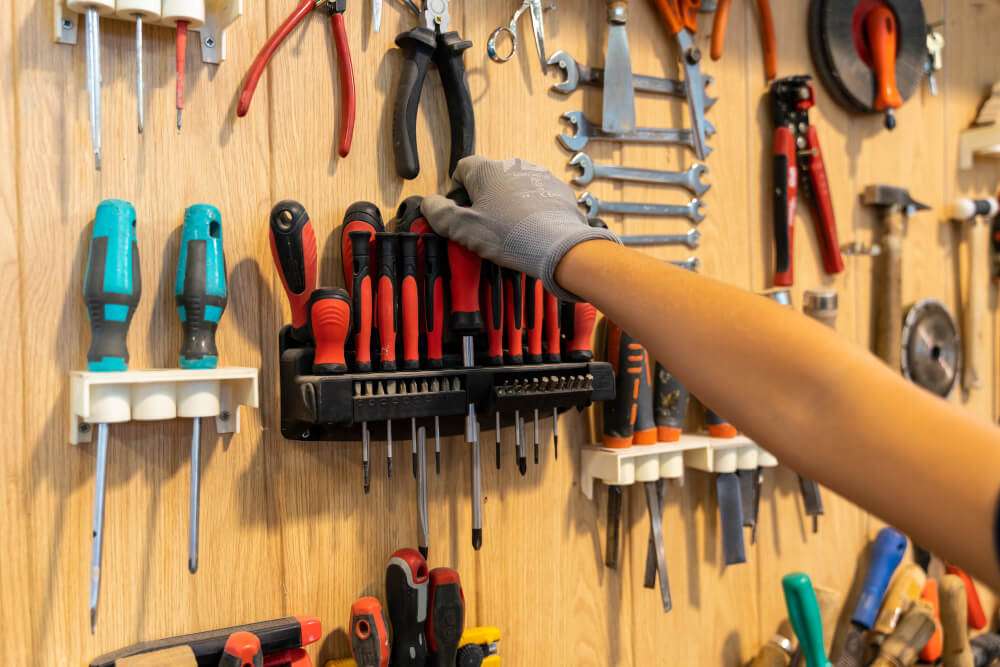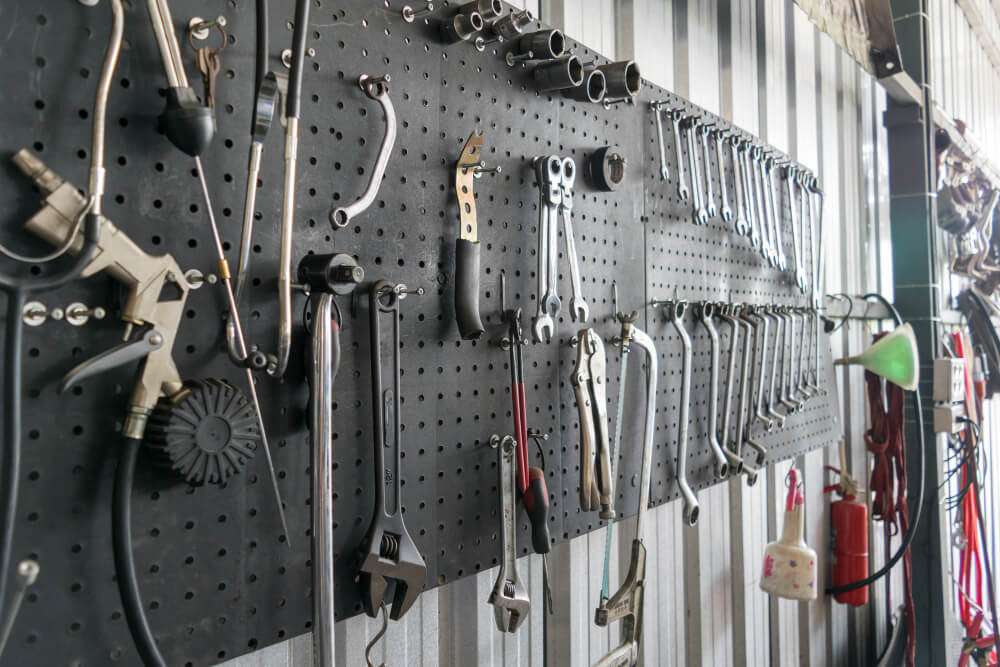
Pegboards are a versatile and essential tool for many businesses, and the material it’s made from can significantly affect their efficacy. It is basically a type of board that presents a series of regularly spaced holes that are arranged in a grid pattern. The holes in the board are used to hold pegs or hooks that can be used to hang tools or other objects.
The Pegboard typically comes in large sheets, which can be cut and installed to fit different sizes and shapes. It is commonly made of wood, metal, or plastic and can be used for a wide range of purposes in various settings due to its versatility.
By using a pegboard, you can keep your workspace organized and improve productivity, since it allows for easy access to tools and materials. So understanding what pegboard is made of and which type of material is most suitable for your specific needs is key.
Let’s discover the available materials, advantages, and potential drawbacks of pegboards.
Comparing the Different Types of Pegboard Materials
There are different types of Pegboard available in the market. When selecting one, it is important to consider the type of material used as it directly affects the board’s strength and resilience.
One commonly used material is wood, which is durable and can be easily customized through sawing or painting. Metal pegboards, on the other hand, are highly resistant to corrosion and are perfect for industrial settings. Plastic/Acrylic pegboards are lightweight and affordable, making them ideal for home use.
Let’s delve into these three different types of pegboard materials in detail and examine their advantages and disadvantages.
1. Masonite/Wood Pegboards

Masonite or wood pegboards are made from a specific type of engineered wood known as MDF – or medium-density fiberboard. To create this material, wood fibers are combined with a resin adhesive under high heat and pressure, which results in a dense, flat board that is exceptionally strong and durable.
Masonite is a popular choice for pegboards due to its smooth surface, which allows pegs and hooks to easily slide in and out of the holes.
Moreover, because MDF is so easy to work with, these pegboards can be customized to fit a variety of different sizing needs or color schemes.
Advantages of Masonite Pegboards
Masonite pegboards are a popular choice for organizing tools and supplies in both residential and commercial settings. One of the biggest advantages of Masonite pegboards is their durability. Made from hardboard, they can withstand daily use and heavy loads.
Another benefit is the ease of installation, requiring only a few simple tools. Also, it is easily available at most hardware stores. It is a cost-effective and practical option for many storage solutions.
Disadvantages of Masonite Pegboards
However, there are a few downsides to using Masonite pegboards. They can be prone to warping and bowing if not properly supported, and the 1/8-inch size pegboard may not be the best option for hanging very heavy tools like drills and power tools.
Moreover, their standard size may not fit all spaces, requiring cutting or piecing together multiple boards to meet specific sizing needs.
2. Metal Pegboards

Metal pegboards are versatile and durable organization tools that can be used in a wide range of settings, from home garages to commercial workshops. These boards are typically made of high-quality steel or aluminum and offer excellent strength and corrosion resistance properties.
Furthermore, the metal is often coated with a rust-resistant finish, further bolstering the board’s durability over time. It provides a customizable and efficient storage system that can be tailored to suit different needs and preferences
To sum up, the use of high-quality metals and precise manufacturing techniques make metal pegboards an excellent choice for those looking for a reliable storage solution.
Advantages of Metal Pegboards
Metal pegboards are an excellent storage solution for those who desire a functional and organized workspace. The primary advantage of metal pegboards is their durability and strength, making them a long-lasting option for heavy-duty tools and equipment.
Besides, metal pegboards are resistant to moisture and rust, ensuring their longevity in both indoor and outdoor environments.
Another advantage of metal pegboards is their adaptability to various accessories and attachments, such as hooks, shelves, and bins providing ample storage options.
Disadvantages of Metal Pegboards
The installation process of metal pegboards can be challenging for some, requiring additional tools and expertise.
They may be more expensive than traditional pegboards, making them less suitable for budget-conscious individuals.
3. Plastic / Acrylic Pegboards
Plastic and acrylic pegboards are innovative alternatives to traditional wooden or metal options. Plastic pegboards are made from a thermoplastic polymer material, which allows for easy and efficient molding of the board.
Acrylic pegboards, on the other hand, are made from polymethyl methacrylate, which is a transparent thermoplastic.
Both materials offer durability and high resistance to impact, making them an ideal choice for any workspace or storage area. The materials are also lightweight and easy to clean, providing a convenient solution for organization and display.
Advantages of Plastic Pegboards
Plastic pegboards have gained popularity as an organizational solution for both residential and commercial spaces. The advantages are clear: they are durable, lightweight, and easy to install, making them an excellent choice for DIY enthusiasts.
Additionally, plastic pegboards are affordable as come ready to mount, with no need for furring strips to buy and install.
Disadvantages of Plastic Pegboards
The clear disadvantage is that plastic pegboards aren’t as sturdy as their metal counterparts. Their strength and durability are limited, which makes them a less-than-ideal choice for heavy and cumbersome items.
Another minor drawback is that plastic pegboards come in limited colors and sizes, hindering their customization options.
Read More : Traditional Pegboards vs Printed Shadow boards? Who wins? You decide.
What Sizes Do Pegboards Come In?
Pegboards may look like simple pieces of board with a series of holes, but they come in a variety of sizes (small, medium, and large). A pegboard’s size is determined by its length, width, and thickness.
These dimensions can vary greatly depending on the manufacturer and intended use. For example, some pegboards may measure 2 feet by 4 feet while others may be as small as 12 inches by 48 inches.
In terms of thickness, pegboards typically range from ¼ to ½ inch. Ultimately, the size of a pegboard will depend on the user’s needs and the space available for installation.
Conclusion
Pegboards are incredibly versatile, as they can be made out of plastic, wood, or metal. Plastic can be great for quick and efficient installations. Metal pegboards offer stylishness and additional strength with an extra support system. Wooden pegboard is relatively inexpensive and works well in most cases. All in all, the choice of material will depend on budget restrictions and functionality needs. With the right material, a sturdy pegboard can handle any task.

